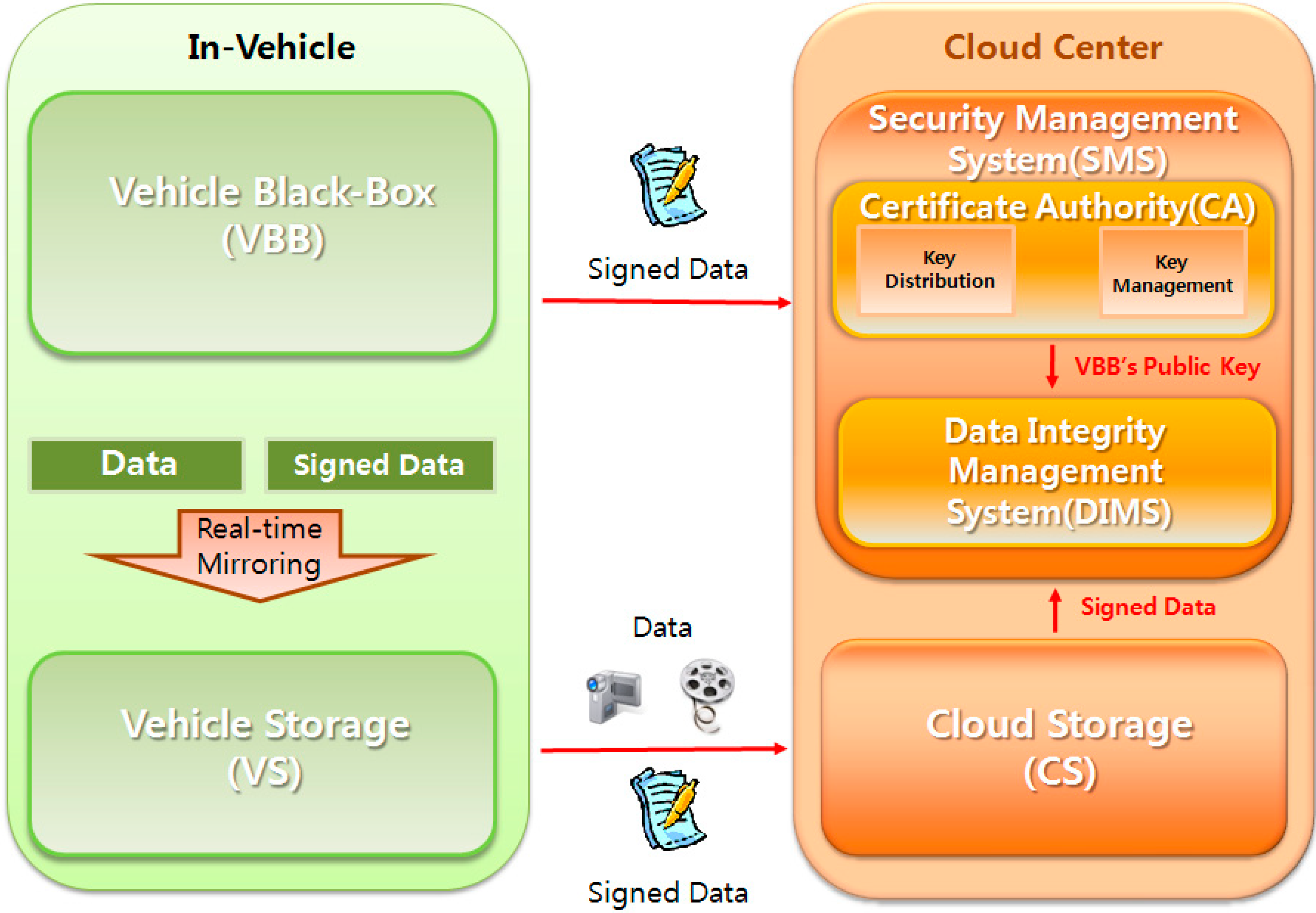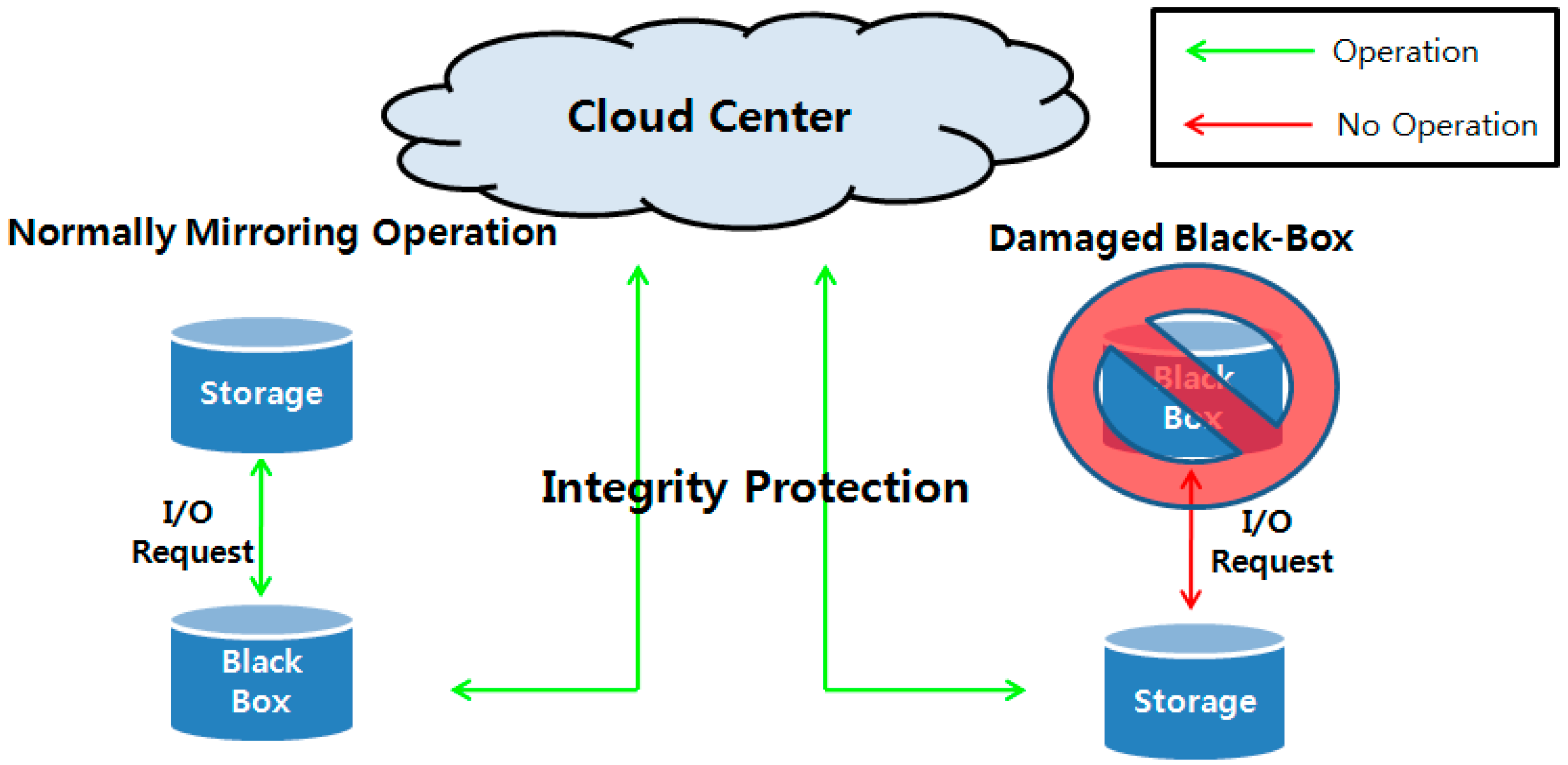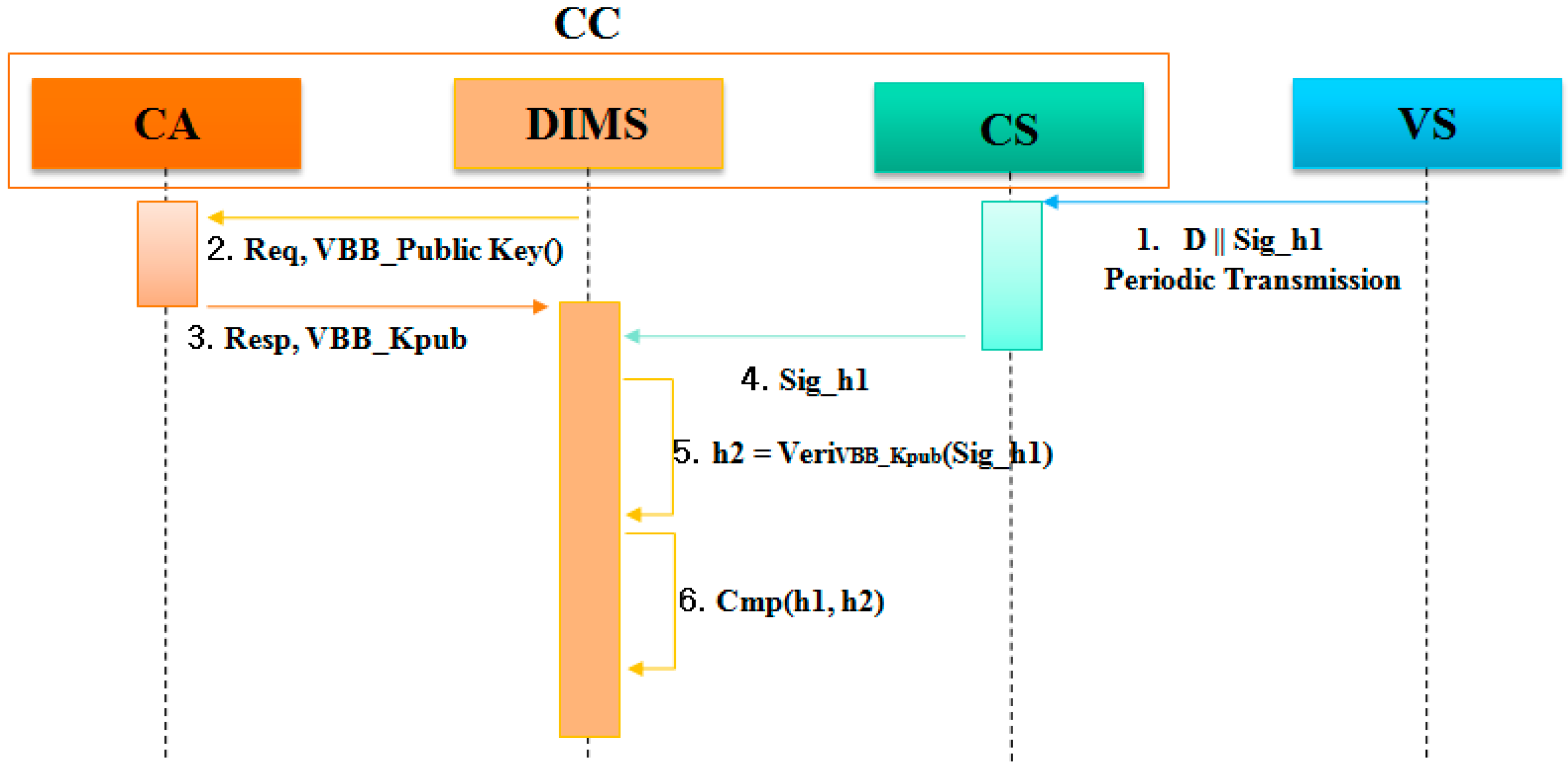VBSM: VCC-Based Black Box Service Model with Enhanced Data Integrity
Abstract
:1. Introduction
2. Related Works
2.1. Security Considerations in VCC
- (1)
- MITM attack: Because VCC makes use of cloud technology, users download black box data using an Internet connection. However, this process is currently done without encryption, such that an attacker could intercept the data or eavesdrop in the middle of the process, compromising the data in a black box. We should therefore consider a protection scheme against man-in-the-middle (MITM) attacks.
- (2)
- Data integrity: Black box data can be forged or modified, thus suggesting the need for a method to preserve the integrity of black box data. If a malicious user attempts to forge or modify downloaded black box data, such as images or voice data, the forged data cannot be guaranteed as forensic evidence. Even if the original data is forged or modified, data integrity should be established by some method, such as a digital signature. Due to this potential problem, the integrity of the data in a black box must be ensured [1].
- (3)
- Data backup and recovery: A vehicle black box should be prepared in the event that damage to the data results. Vehicle black boxes are always exposed to the risk of a traffic accident. When a major accident occurs, a vehicle black box that is installed on the front side of a vehicle is likely to be damaged. Accordingly, we should consider an alternative scheme for a damaged vehicle black box by mirroring the data contained in it.
2.2. Existing Research
2.3. Core Technologies
3. The Proposed VBSM

3.1. Black Box Data Mirroring

3.2. VBSM Service Scenario
3.2.1. VBSM of General Operation
| Terms | Explanation |
|---|---|
| Regt () | Register function |
| Hash () | Hash function |
| Sig () | Digital signature algorithm |
| Veri () | Verify function |
| Cmp () | Compare function |
| D | Data: vehicle black box (VBB) |
| h1 | Hash value of the data |
| Sig_h1 | Digital signature for h1 data |
| h2 | Hash value of the verified Sig _h1 |

- Step 1 VBB: Generate_K_pair (VBB_Kprv, VBB_Kpub)The black box generates a key pair, such as the VBB's private and public keys.
- Step 2 VBB→CA: Registering the VBB_KpubThe black box registers the VBB’s public key at the certificate authority.
- Step 3 VBB: h1 = Hash(D)The black box calculates a hash value for data such as video, pictures and voice data in the VBB.
- Step 4 VBB: Sig_h1 = SigVBB_Kprv(h1).The black box generates a digital signature using the VBB’s private key and the hash value from Step 3.
- Step 5 VBB→DIMS: Sig_h1The Sig_h1 is transferred from the vehicle black box to a data integrity management system.
- Step 6 VBB→VS: D || Sig_h1Data, such as video, pictures and voice data, in the VBB and Sig_h1, are transferred from the black box into vehicle storage.
- Step 7 DIMS→CA: Requesting the VBB_KpubThe data integrity management system requests the VBB’s public key from the certificate authority.
- Step 8 CA→DIMS: Responding with the VBB_KpubThe certificate authority distributes the VBB’s public key to the data integrity management system.
- Step 9 DIMS: h1 = VeriVBB_Kpub(Sig_h1)The data integrity management system verifies the Sig_h1 and stores the h1.
3.2.2. VBSM’s Special Cases Operation

- Step 1 VS→CS: D || Sig_h1From the CC, data and Sig_h1 in the vehicle storage are periodically transferred to cloud storage.
- Step 2 DIMS→CA: Requesting the VBB_Kpub.The data integrity management system requests the VBB’s public key from the certificate authority.
- Step 3 CA→DIMS: Responding with the VBB_KpubThe certificate authority distributes the VBB’s public key to the data integrity management system.
- Step 4 CS→DIMS: Sig_h1Cloud storage transfers a Sign_h1 to the data integrity management system for data integrity.
- Step 5 DIMS: h2 = VeriVBB_Kpub(Sig_h1)The data integrity management system verifies the Sig_h1 and stores h2.
- Step 6 DIMS: Cmp(h1, h2)The data integrity management system compares the hash values of h1 and h2.
3.3. Efficiency Analyses of VBSM
4. Conclusions
Acknowledgments
Author Contributions
Conflicts of Interest
References
- Han, J.W.; Lee, B.G.; Son, M.H.; Choi, B.C.; Kim, M.S.; Na, J.C.; Cho, H.S. Security Trends in Intelligent Vehicle Transport System. In Electronics and Telecommunications Trends; Electronics and Telecommunications Research Institute: Daejeon, Korea, 2013; pp. 86–94. [Google Scholar]
- Kim, M.S.; Choi, S.G.; Jeong, C.Y.; Han, J.W. Security Issues and Trends in Vehicle Black box. In Electronics and Telecommunications Trends; Electronics and Telecommunications Research Institute: Daejeon, Korea, 2012; pp. 123–129. [Google Scholar]
- Jeong, S.-W.; Park, Y.-H. Integrated video management system for vehicle black box using the mobile cloud. J. Korea Inst. Inf. Commun. Eng. 2013, 17, 2352–2358. [Google Scholar] [CrossRef]
- Kim, M.; Nam, J.-H.; Jang, J.-W. Implementation of smart car infotainment system including black box and self-diagnosis function. Int. J. Softw. Eng. Appl. 2014, 18, 267–274. [Google Scholar]
- Kim, Y.Y.; Kim, B.H.; Lee, D.H. Real-time integrity for vehicle black box system. J. Korea Inst. Inf. Secur. Cryptol. 2009, 19, 49–61. [Google Scholar]
- Choi, S.-O.; Kim, Y.-P.; Im, Y.-S.; Kim, Y.-J.; Kang, E.-Y. Smart Moblie Blackbox DVR in car Environment. J. Inst. Internet Broadcast. Commun. 2013, 13, 9–15. [Google Scholar]
- Kim, M.S.; Jeong, C.Y. An Efficient Data Integrity Scheme for Preventing Falsification of Car Black box. In Proceedings of the 2013 International Conference on ICT Convergence (ICTC), Jeju, Korea, 14–16 October 2013.
- Nguyen, D.L.; Lee, M.-E.; Lensky, A. The Design and Implementation of New Vehicle Black box Using the OBD Information. In Proceedings of the 2012 7th International Conference on Computing and Convergence Technology (ICCCT), Seoul, Korea, 3–5 December 2012.
- Verkhovsky, B.S. Public-key cryptosystems with secret encryptor and digital signature. Int. J. Innov. Technol. Explor. Eng. 2013, 2, 321–325. [Google Scholar]
- Noroozi, E.; Daud, S.M.; Sabouhi, A. Secure digital signature schemes based on hash functions. Int. J. Commun. Netw. Syst. Sci. 2013, 6, 1–6. [Google Scholar]
- Wan, H.; Cho, H.E.; Heon, Y.; Yeom, A. Study on mirroring for high-availability cloud storage. J. Korean Inst. Inf. Sci. Eng. 2011, 38, 273–276. [Google Scholar]
- Meckel, H.; Stephan, C.; Bunse, C.; Krafzik, M.; Reher, C.; Kohl, M.; Meyer, H.E.; Eisenacher, M. The amino acid’s backup bone—storage solutions for proteomics facilities. Biochim. Biophys. Acta 2014, 1844, 2–11. [Google Scholar] [CrossRef]
© 2014 by the authors; licensee MDPI, Basel, Switzerland. This article is an open access article distributed under the terms and conditions of the Creative Commons Attribution license (http://creativecommons.org/licenses/by/4.0/).
Share and Cite
Kang, W.M.; Lee, J.D.; Park, J.H. VBSM: VCC-Based Black Box Service Model with Enhanced Data Integrity. Information 2014, 5, 526-534. https://doi.org/10.3390/info5040526
Kang WM, Lee JD, Park JH. VBSM: VCC-Based Black Box Service Model with Enhanced Data Integrity. Information. 2014; 5(4):526-534. https://doi.org/10.3390/info5040526
Chicago/Turabian StyleKang, Won Min, Jae Dong Lee, and Jong Hyuk Park. 2014. "VBSM: VCC-Based Black Box Service Model with Enhanced Data Integrity" Information 5, no. 4: 526-534. https://doi.org/10.3390/info5040526





